ISLAMIC CITY OF MARAWI — As the afternoon sun flared up to its scorching glory, internally displaced persons (IDPs) — mostly women since the men were away eking out a living — huddled under the shade of trees in the filthy “tent city” evacuation site in the village of Bito Buadi Itowa.
Like the city’s Ground Zero that is bereft of residents save for some stray dogs and cats, the tents, many of them tattered due to their exposure to the elements for almost two years now, are empty of people who sought comfort in a tree-shaded tent nearby.
“When it rains here, it leaks. When the sun is high, it is very hot inside. The heat is intolerable,” Norphia Dipatuan, mother of six lamented. The Dipatuans lived in Barangay Dagubduban until they were forced to flee in May 2017 – 22 months ago.
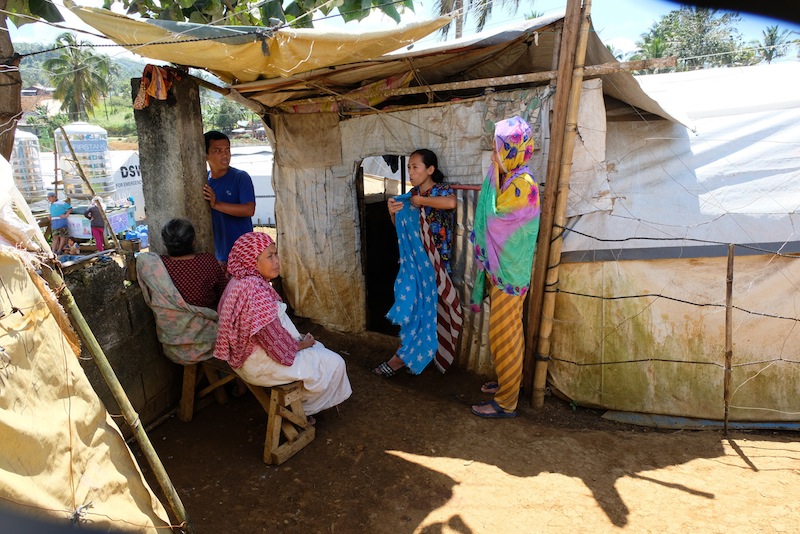
Evacuees get out of their tents to seek refuge from the shade of a tree at the tent city evacuation center at Barangay Bito Buadi Itowa. BONG SARMIENTO
On October 17, 2017, President Rodrigo Duterte declared military victory against the Islamic State-aligned Maute and Abu Sayyaf groups which laid siege on the country’s lone Islamic City on May 23, 2017, after government’s failed attempt to arrest Abu Sayyaf Group leader Isnilon Hapilon, the Emir of the IS in Southeast Asia.
“Ladies and gentlemen, I hereby declare Marawi City liberated from the terrorist influence that marks the beginning of rehabilitation for the people,” the country’s first and only president from Mindanao, who claims to have a Meranaw bloodline, said.
On October 17, 2017, President Rodrigo Duterte declared military victory against the Islamic State-aligned Maute and Abu Sayyaf groups which laid siege on the country’s lone Islamic City on May 23, 2017, after government’s failed attempt to arrest Abu Sayyaf Group leader Isnilon Hapilon, the Emir of the IS in Southeast Asia.
“Ladies and gentlemen, I hereby declare Marawi City liberated from the terrorist influence that marks the beginning of rehabilitation for the people,” the country’s first and only president from Mindanao, who claims to have a Meranaw bloodline, said.
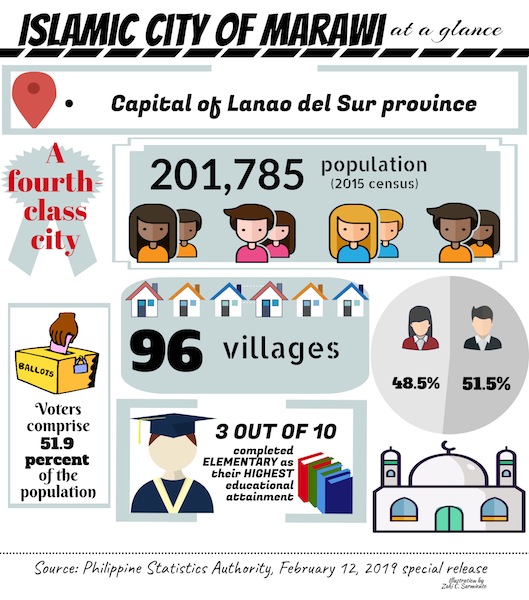
Infographics by ZAKI C. SARMIENTO
However, it took over a year and several postponements later, for the Task Force Bangon Marawi (TBFM) to finally hold on October 30, 2018 its groundbreaking rites for the rehabilitation of Ground Zero.
As of end of March 2019, however, some 12,700 families or around 70,000 individuals out of 360,000 who were forced to flee Marawi in May 2017, continue to suffer in squalid evacuation sites like the Dipatuans, in transitional shelters, in relatives’ houses.
Still piled up in ruins nearly18 months after “liberation,” the 250-hectare Ground Zero, the former main battle area — now referred to as MAA or Most Affected Area – remains a horrific sight and the horizon offers little hope for the devastated city to rise quickly from the ashes of war.
As of posting time, the MAA continues to be a restricted area for its 27,000 residents across 24 villages , including the “renters and sharers” of commercial and residential properties.
To recall, the TFBM had negotiated with two different consortiums led by state-owned Chinese companies, to become the single developer for Marawi’s rehabilitation using the Swiss Challenge, a method where an unsolicited proposal for a public project is chosen and offered for matching by other proponents.
The negotiations did not succeed.
Drieza Lininding, chair of the Marawi-based civic organization Moro Consensus Group, blamed the negotiations with the Chinese firms partly for the delay in efforts to bring back the lost glory of the lakeside city.
Chinese-led
“Months after the liberation of Marawi, no groundbreaking happened because they (TFBM) were busy talking with the Chinese-led consortium to rehabilitate the city through a joint venture agreement…It consumed a lot of time (that delayed the start of rehabilitation at Ground Zero),” Liningding said in an interview on March 20, at the sidelines of the first ever Congressional inquiry by the Lower House Committee on Disaster Management, Sub-Committee on Marawi Rehabilitation.
However, it took over a year and several postponements later, for the Task Force Bangon Marawi (TBFM) to finally hold on October 30, 2018 its groundbreaking rites for the rehabilitation of Ground Zero.
As of end of March 2019, however, some 12,700 families or around 70,000 individuals out of 360,000 who were forced to flee Marawi in May 2017, continue to suffer in squalid evacuation sites like the Dipatuans, in transitional shelters, in relatives’ houses.
Still piled up in ruins nearly18 months after “liberation,” the 250-hectare Ground Zero, the former main battle area — now referred to as MAA or Most Affected Area – remains a horrific sight and the horizon offers little hope for the devastated city to rise quickly from the ashes of war.
As of posting time, the MAA continues to be a restricted area for its 27,000 residents across 24 villages , including the “renters and sharers” of commercial and residential properties.
To recall, the TFBM had negotiated with two different consortiums led by state-owned Chinese companies, to become the single developer for Marawi’s rehabilitation using the Swiss Challenge, a method where an unsolicited proposal for a public project is chosen and offered for matching by other proponents.
The negotiations did not succeed.
Drieza Lininding, chair of the Marawi-based civic organization Moro Consensus Group, blamed the negotiations with the Chinese firms partly for the delay in efforts to bring back the lost glory of the lakeside city.
Chinese-led
“Months after the liberation of Marawi, no groundbreaking happened because they (TFBM) were busy talking with the Chinese-led consortium to rehabilitate the city through a joint venture agreement…It consumed a lot of time (that delayed the start of rehabilitation at Ground Zero),” Liningding said in an interview on March 20, at the sidelines of the first ever Congressional inquiry by the Lower House Committee on Disaster Management, Sub-Committee on Marawi Rehabilitation.
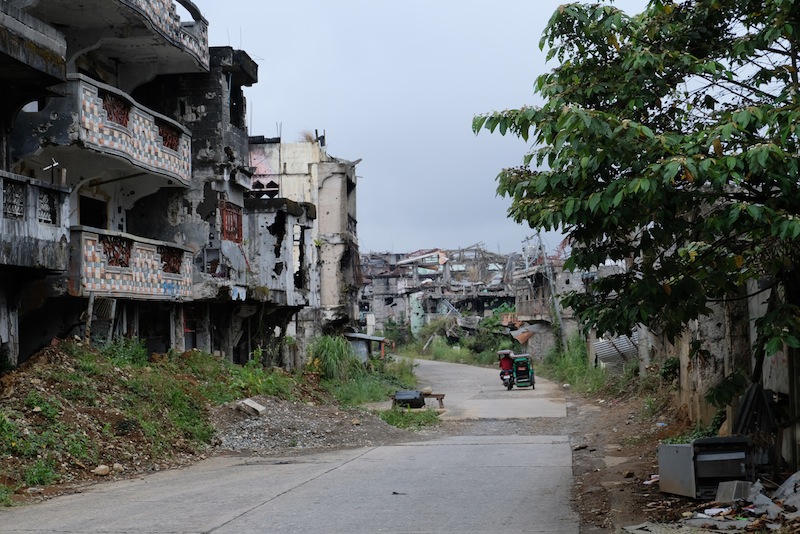
A tricycle maneuvers at a portion of Ground Zero that authorities already cleared for passage to all kinds of vehicles. BONG S. SARMIENTO
The first proponent, Bagong Marawi Consortium (BMC), was selected in March 2018 and three months later in June, the TFBM terminated negotiations with the group due to its “inability to submit legal, technical, and financial documents in proper form, to prove the Consortium’s Legal Capacity, Technical Capacity, and Financial Capacity — all requisites to participate in the Joint Venture Activity as prescribed in the JV Guidelines.”
Led by China State Construction Engineering Corp. Ltd. (CSCEC), which is owned by the Chinese government, BMC is also composed of China Geo Engineering Corp. (CGC), Anhui Huali Construction Group Co. Ltd., TBEA Co. Ltd., and Shandong Jinyuan Homes Industry Development Co. Ltd.
In 2009, the World Bank disclosed it had blacklisted CSCEC and CGC for allegedly conspiring with Philippines companies in rigging the bidding of road projects in the country partly financed by the international lender.
Local firms in the consortium were Future Homes Philippines Inc., A Brown Company Inc., H.S. Pow Construction and Development, and SDW Realty & Development Inc.
BMC filed a motion for reconsideration but the Bangon Marawi Selection Committee, the bids and awards body of TFBM, did not issue a final ruling, TFBM Field Office Manager Felix Castro, Jr., also an assistant secretary at the Housing and Urban Development Coordinating Council, told MindaNews in a text message on March 27.
“The motion of BMC is moot and academic with the shift of procurement (to public bidding). (We will) no longer (entertain a) single developer. But they could compete in the regular bidding process,” he added.
After BMC was disqualified, TFBM started negotiations with a consortium led by Power Construction Corporation of China Ltd. (PowerChina), another Chinese government owned company. The task force, officials said, terminated talks with PowerChina as the sole developer to avoid legal problems in pursuing the entire rehabilitation of Marawi by way of a joint venture agreement.
Even if the two Chinese-led consortiums are now out of the equation as a single developer for Marawi’s delayed rehabilitation, sentiments against China’s involvement to rebuild the city continue to drift in the air.
“No way. We don’t want Chinese involvement, especially state-owned Chinese corporations,” said civil society’s Lininding, when asked if they will still welcome Chinese contractors in the rehabilitation of their war-torn city.
Long wait
Lininding lamented the long wait to return to their houses in MAA, and lashed out at the snail-paced efforts to reconstruct Ground Zero. The debris management of Sector 1 — out of the nine sectors in the MAA — was awarded to FINMAT International Resources, Inc, a Filipino firm, which was suspended last December after it allegedly demolished houses without the consent of the owners.
The first proponent, Bagong Marawi Consortium (BMC), was selected in March 2018 and three months later in June, the TFBM terminated negotiations with the group due to its “inability to submit legal, technical, and financial documents in proper form, to prove the Consortium’s Legal Capacity, Technical Capacity, and Financial Capacity — all requisites to participate in the Joint Venture Activity as prescribed in the JV Guidelines.”
Led by China State Construction Engineering Corp. Ltd. (CSCEC), which is owned by the Chinese government, BMC is also composed of China Geo Engineering Corp. (CGC), Anhui Huali Construction Group Co. Ltd., TBEA Co. Ltd., and Shandong Jinyuan Homes Industry Development Co. Ltd.
In 2009, the World Bank disclosed it had blacklisted CSCEC and CGC for allegedly conspiring with Philippines companies in rigging the bidding of road projects in the country partly financed by the international lender.
Local firms in the consortium were Future Homes Philippines Inc., A Brown Company Inc., H.S. Pow Construction and Development, and SDW Realty & Development Inc.
BMC filed a motion for reconsideration but the Bangon Marawi Selection Committee, the bids and awards body of TFBM, did not issue a final ruling, TFBM Field Office Manager Felix Castro, Jr., also an assistant secretary at the Housing and Urban Development Coordinating Council, told MindaNews in a text message on March 27.
“The motion of BMC is moot and academic with the shift of procurement (to public bidding). (We will) no longer (entertain a) single developer. But they could compete in the regular bidding process,” he added.
After BMC was disqualified, TFBM started negotiations with a consortium led by Power Construction Corporation of China Ltd. (PowerChina), another Chinese government owned company. The task force, officials said, terminated talks with PowerChina as the sole developer to avoid legal problems in pursuing the entire rehabilitation of Marawi by way of a joint venture agreement.
Even if the two Chinese-led consortiums are now out of the equation as a single developer for Marawi’s delayed rehabilitation, sentiments against China’s involvement to rebuild the city continue to drift in the air.
“No way. We don’t want Chinese involvement, especially state-owned Chinese corporations,” said civil society’s Lininding, when asked if they will still welcome Chinese contractors in the rehabilitation of their war-torn city.
Long wait
Lininding lamented the long wait to return to their houses in MAA, and lashed out at the snail-paced efforts to reconstruct Ground Zero. The debris management of Sector 1 — out of the nine sectors in the MAA — was awarded to FINMAT International Resources, Inc, a Filipino firm, which was suspended last December after it allegedly demolished houses without the consent of the owners.
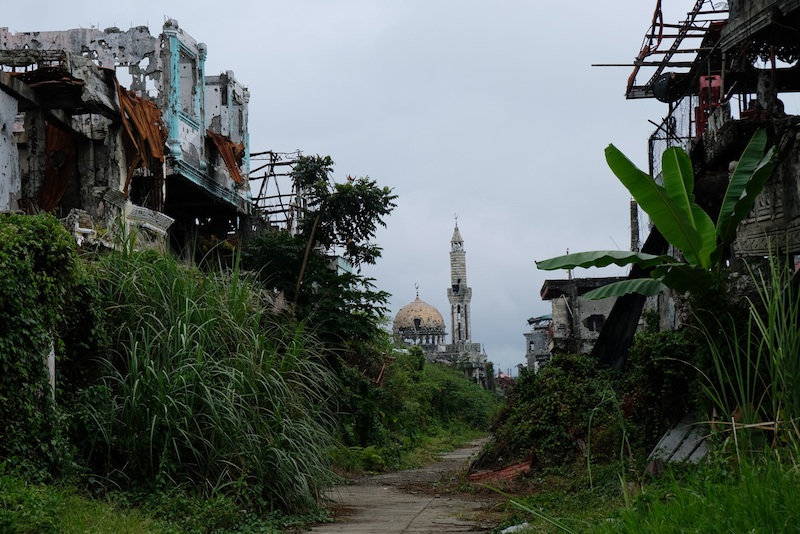
Plants have grown tall at damaged infrastructures in a portion of Ground Zero still restricted to residents. BONG S. SARMIENTO
To be sure, China had responded to calls to help Marawi recover from the scars of war, donating heavy equipment worth $3 million that have been deployed in the construction of transitional shelters outside Ground Zero. Beijing also committed a grant of P1.1 billion ($20.84 million) during the pledging session for the Bangon Marawi Comprehensive Rehabilitation and Reconstruction Program (BMCRRP) in Davao City last November.
In June 2017, China also donated firearms and ammunition worth around P370 million ($7 million) to help Filipino troops fight the Islamic militants in Marawi, besides the P15 million ($284,546) donation for relief assistance to the victims of the siege.
Lininding thanked Beijing for her “heartily given assistance” to Marawi, which administration officials attributed to be one of the results of the warming up of relations between China and the Philippines after Duterte’s pivot to the former as part of his pursuit of an “independent foreign policy” during his first year in office.
To be sure, China had responded to calls to help Marawi recover from the scars of war, donating heavy equipment worth $3 million that have been deployed in the construction of transitional shelters outside Ground Zero. Beijing also committed a grant of P1.1 billion ($20.84 million) during the pledging session for the Bangon Marawi Comprehensive Rehabilitation and Reconstruction Program (BMCRRP) in Davao City last November.
In June 2017, China also donated firearms and ammunition worth around P370 million ($7 million) to help Filipino troops fight the Islamic militants in Marawi, besides the P15 million ($284,546) donation for relief assistance to the victims of the siege.
Lininding thanked Beijing for her “heartily given assistance” to Marawi, which administration officials attributed to be one of the results of the warming up of relations between China and the Philippines after Duterte’s pivot to the former as part of his pursuit of an “independent foreign policy” during his first year in office.
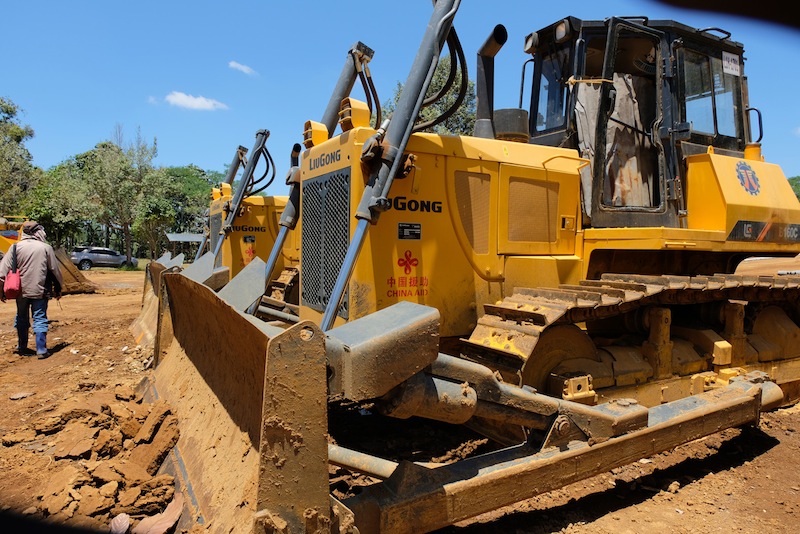
Heavy equipment donated by China are used to build transitional shelters such as this one in Barangay Rorogagus. BONG S. SARMIENTO
Further stressing opposition to Chinese involvement in the rehabilitation of Marawi, Lininding cited that China has built a “notorious reputation” in terms of investing in other countries, referring to Sri Lanka, which was struggling to pay over $8 billion it owed to state-owned Chinese firms. It was touted as a “debt trap.” In December 2017, Sri Lanka handed over the strategic Hambantota port to a Chinese firm on a 99-year debt-for-equity settlement. The deal was valued at $1.1 billion.
“We are afraid, especially we have Lake Lanao as a resource. We don’t want to see Chinese firms taking control of (the lake) if we can’t repay the cost they will incur in rebuilding our city,” Lininding told MindaNews.
“A gift from the Chinese government”
Lake Lanao is the second largest lake in the Philippines and the largest in Mindanao. It is a major source of hydropower in the south.
But Li Lin, consul general of the recently-opened Consulate General of the People’s Republic of China in Davao City, said Beijing wants to help rebuild Marawi in a bid to strengthen their improving ties with Manila, laughing off the anti-Chinese sentiments in Marawi as “baseless.”
“The support from China to participate in post-war Marawi… is a gift from the Chinese government. Apart from that, probably there would be some cooperation projects plus private sector and state-owned companies that will invest in Marawi. That will be a win-win cooperation. It’s not money that will be lent to Philippines but Chinese companies coming in to invest (in Marawi)” he told MindaNews on April 2 at the Chinese consular office in Davao City.
For one, China will donate a fund for the construction of a bridge inside Ground Zero, Li said, wondering — in response to anti-Chinese sentiments in the Islamic city — how such a project from China would put Marawi at risk.
He lamented that China or state-owned Chinese companies are being made the scapegoat for the delay to rehabilitate Marawi.
“I hope this is from a small number of people misled by Western media, or stories told by opposition parties. It sounds very strange to me. (Even) if it is a general public opinion, that you have this kind of worries, or even this strong sentiment against (China), this is “groundless,” Li said.
He reiterated the help for Marawi to rise from the ashes of war from the Chinese government and people “is very sincere.”
72.2 billion pesos
Data from the Department of Finance (DoF) estimated that P72.20 billion ($1.39 billion) is needed for the reconstruction and rehabilitation of Marawi.
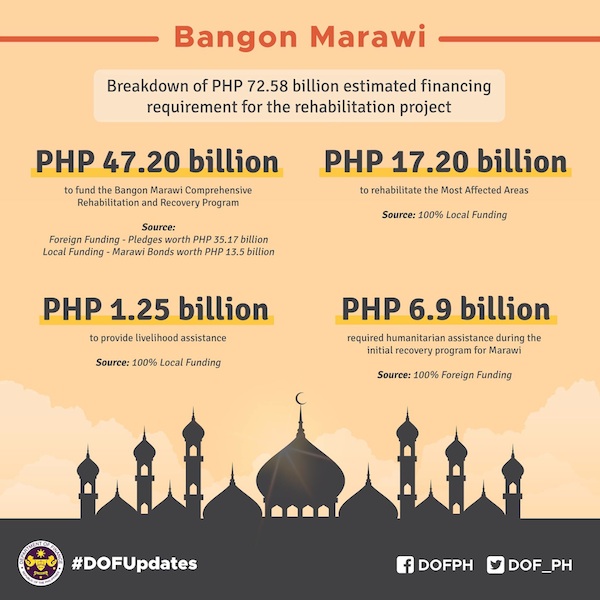
Further stressing opposition to Chinese involvement in the rehabilitation of Marawi, Lininding cited that China has built a “notorious reputation” in terms of investing in other countries, referring to Sri Lanka, which was struggling to pay over $8 billion it owed to state-owned Chinese firms. It was touted as a “debt trap.” In December 2017, Sri Lanka handed over the strategic Hambantota port to a Chinese firm on a 99-year debt-for-equity settlement. The deal was valued at $1.1 billion.
“We are afraid, especially we have Lake Lanao as a resource. We don’t want to see Chinese firms taking control of (the lake) if we can’t repay the cost they will incur in rebuilding our city,” Lininding told MindaNews.
“A gift from the Chinese government”
Lake Lanao is the second largest lake in the Philippines and the largest in Mindanao. It is a major source of hydropower in the south.
But Li Lin, consul general of the recently-opened Consulate General of the People’s Republic of China in Davao City, said Beijing wants to help rebuild Marawi in a bid to strengthen their improving ties with Manila, laughing off the anti-Chinese sentiments in Marawi as “baseless.”
“The support from China to participate in post-war Marawi… is a gift from the Chinese government. Apart from that, probably there would be some cooperation projects plus private sector and state-owned companies that will invest in Marawi. That will be a win-win cooperation. It’s not money that will be lent to Philippines but Chinese companies coming in to invest (in Marawi)” he told MindaNews on April 2 at the Chinese consular office in Davao City.
For one, China will donate a fund for the construction of a bridge inside Ground Zero, Li said, wondering — in response to anti-Chinese sentiments in the Islamic city — how such a project from China would put Marawi at risk.
He lamented that China or state-owned Chinese companies are being made the scapegoat for the delay to rehabilitate Marawi.
“I hope this is from a small number of people misled by Western media, or stories told by opposition parties. It sounds very strange to me. (Even) if it is a general public opinion, that you have this kind of worries, or even this strong sentiment against (China), this is “groundless,” Li said.
He reiterated the help for Marawi to rise from the ashes of war from the Chinese government and people “is very sincere.”
72.2 billion pesos
Data from the Department of Finance (DoF) estimated that P72.20 billion ($1.39 billion) is needed for the reconstruction and rehabilitation of Marawi.

Of this amount, P47.20 billion ($901 million) is needed for the Bangon Marawi Comprehensive Rehabilitation and Reconstruction Program (BMCRRP); P17.20 billion ($328.3 million) that will be 100 percent sourced from local funding will be spent to rehabilitate the MAA; and P1.25 billion ($23.9 million) will be spent for livelihood assistance, which would also be fully sourced from local funds. The overall financing requirement also includes the P6.9 billion ($130.64 million) in humanitarian assistance required during the early stages of the recovery program for Marawi.
During the pledging session in November in Davao City, P35.1 billion ($665.20 million) were raised for BMCRRP, of which 32.7 billion ($619,73 million) or 93 percent is in the form of concessional loans from international lenders and foreign governments. The rest, P2.4 billion ($45.50 million), are grants from China (P1.10 billion or $20.84 million) and Japan (P928.38 million or $17.59 million).
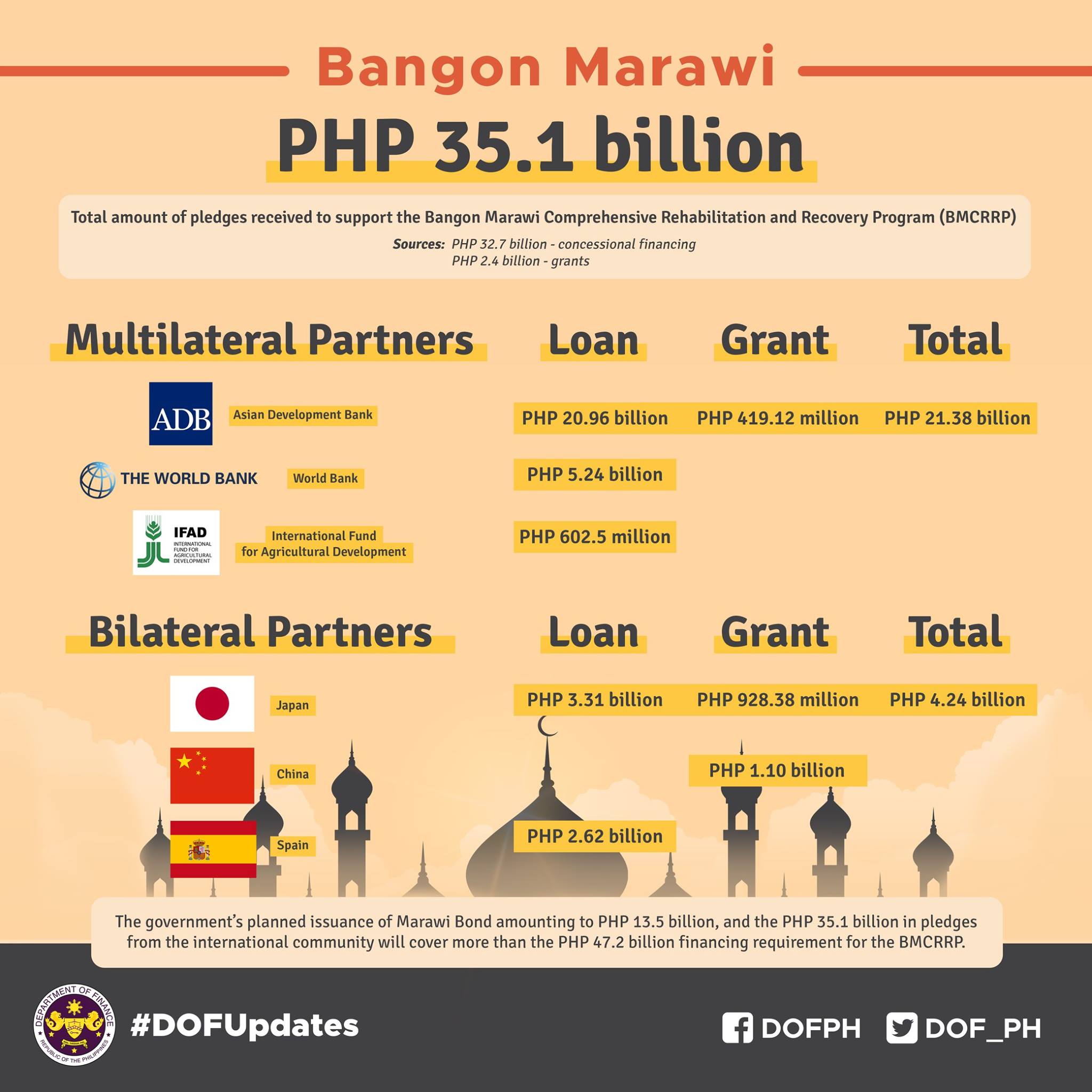
During the pledging session in November in Davao City, P35.1 billion ($665.20 million) were raised for BMCRRP, of which 32.7 billion ($619,73 million) or 93 percent is in the form of concessional loans from international lenders and foreign governments. The rest, P2.4 billion ($45.50 million), are grants from China (P1.10 billion or $20.84 million) and Japan (P928.38 million or $17.59 million).

The P35.10 billion in loans and grants generated during the pledging session in Davao City last November would cover around 75% of the BMCRRP funding requirement.
So far, the global community contributed humanitarian assistance worth at least P6.9 billion ($130.64 million) for relief operations, DoF data showed.
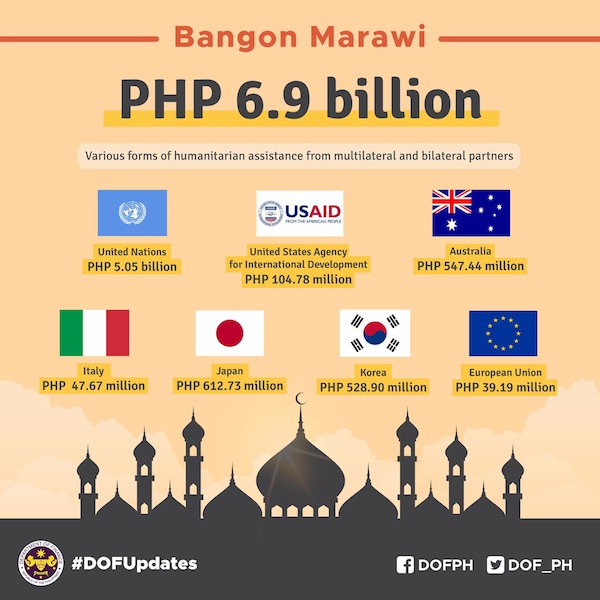
So far, the global community contributed humanitarian assistance worth at least P6.9 billion ($130.64 million) for relief operations, DoF data showed.

Lininding lamented the lack of progress at Ground Zero and the fact that at least 27,000 people have not been allowed to return to their homes there nearly 18 months after “liberation.”
On March 20, residents, including students, peacefully marched in the streets of Marawi to demand that they be allowed to return to their homes ravaged by the urban warfare that left 1,100 people dead, mostly Islamic militants.
The protest action was held in time for the first ever Congressional inquiry by the Lower House Committee on Disaster Management, Sub-Committee on Marawi Rehabilitation.
The hearing, attended by hundreds of residents, gave the locals the venue to ventilate their dissatisfaction, anger and frustration, among others, over the slow pace of rehabilitation.
Abdul Hamidullah Atar, the Sultan of Marawi, chided the government for failing on its promise to expedite the rehabilitation of their city, stressing that thousands of families are still languishing in various evacuation and transitional shelter sites that have ”dehumanized” them for the past two years.
Stakeholders as decision-makers
“We wanted to see stakeholders’ actually taking part in decision-making to chart the rehabilitation and reconstruction of their respective homes and the city,” Atar said in a manifesto submitted to the legislative inquiry.
In a separate interview, the sultan lamented the lack of consultation on the master development plan for the MAA, a claim that TFBM officials denied in several public occasions.
“What happened was a presentation and not consultation of the MAA rehabilitation plan to the public,” he told MindaNews, pointing out TFBM’s MAA master development plan was the same as the one crafted by the Chinese-led Bagong Marawi Consortium.
The master plan was rammed into our throats because there was “no real consultation” with the locals, he said, asking, “Did they consult with the landowners, for instance, where the studio or the museum will be built?”
TFBM now refers to the MAA master plan as the Marawi RISE Plan, with R standing for resilience, I for identity, S for sustainability, and E for evolution.
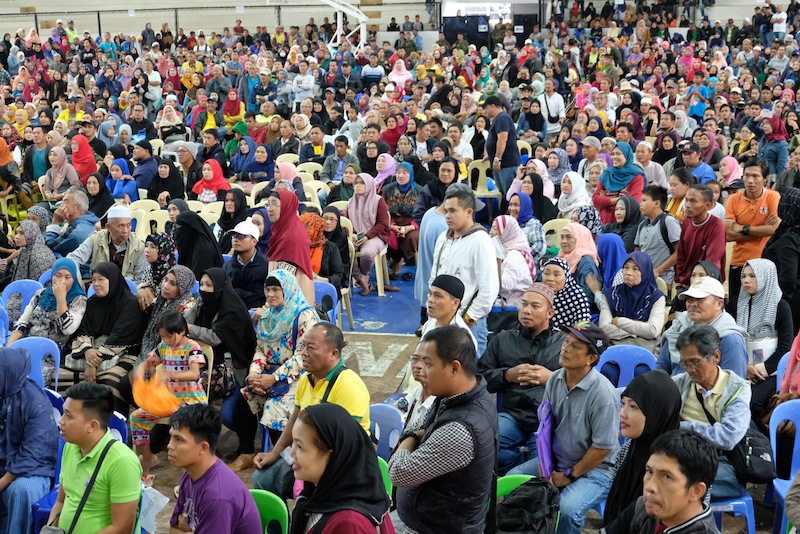
On March 20, residents, including students, peacefully marched in the streets of Marawi to demand that they be allowed to return to their homes ravaged by the urban warfare that left 1,100 people dead, mostly Islamic militants.
The protest action was held in time for the first ever Congressional inquiry by the Lower House Committee on Disaster Management, Sub-Committee on Marawi Rehabilitation.
The hearing, attended by hundreds of residents, gave the locals the venue to ventilate their dissatisfaction, anger and frustration, among others, over the slow pace of rehabilitation.
Abdul Hamidullah Atar, the Sultan of Marawi, chided the government for failing on its promise to expedite the rehabilitation of their city, stressing that thousands of families are still languishing in various evacuation and transitional shelter sites that have ”dehumanized” them for the past two years.
Stakeholders as decision-makers
“We wanted to see stakeholders’ actually taking part in decision-making to chart the rehabilitation and reconstruction of their respective homes and the city,” Atar said in a manifesto submitted to the legislative inquiry.
In a separate interview, the sultan lamented the lack of consultation on the master development plan for the MAA, a claim that TFBM officials denied in several public occasions.
“What happened was a presentation and not consultation of the MAA rehabilitation plan to the public,” he told MindaNews, pointing out TFBM’s MAA master development plan was the same as the one crafted by the Chinese-led Bagong Marawi Consortium.
The master plan was rammed into our throats because there was “no real consultation” with the locals, he said, asking, “Did they consult with the landowners, for instance, where the studio or the museum will be built?”
TFBM now refers to the MAA master plan as the Marawi RISE Plan, with R standing for resilience, I for identity, S for sustainability, and E for evolution.

MAA residents listen during the “Consultation Dialogue with the IDPs (internally displace persons) within the MAA (24 barangays) in Marawi City” on March 19, 2019 at the provincial capitol gymnasium.
Atar said local contractors should undertake the rehabilitation of Marawi, and not foreigners.
Like Lininding, Atar worries over Chinese involvement in the rehabilitation of Marawi.
“Many Meranaws (or the people of Marawi) refuse to have Chinese contractors (take part in the reconstruction of the city),” the sultan said.
He feared that if contractors from China will bag the rehabilitation project, they will bring in Chinese workers, citing the rush of Chinese workers to the country employed in offshore gaming operations, that might render local construction workers jobless.
The traditional leader appealed that Marawi residents be given the priority in the hiring process once rehabilitation work goes full throttle to help them get back on their feet.
Consul General Li said construction workers “would be majority Filipinos in case Chinese firms would undertake construction projects in Marawi.”
But when can Ground Zero residents go back to their homes?
Atar said local contractors should undertake the rehabilitation of Marawi, and not foreigners.
Like Lininding, Atar worries over Chinese involvement in the rehabilitation of Marawi.
“Many Meranaws (or the people of Marawi) refuse to have Chinese contractors (take part in the reconstruction of the city),” the sultan said.
He feared that if contractors from China will bag the rehabilitation project, they will bring in Chinese workers, citing the rush of Chinese workers to the country employed in offshore gaming operations, that might render local construction workers jobless.
The traditional leader appealed that Marawi residents be given the priority in the hiring process once rehabilitation work goes full throttle to help them get back on their feet.
Consul General Li said construction workers “would be majority Filipinos in case Chinese firms would undertake construction projects in Marawi.”
But when can Ground Zero residents go back to their homes?
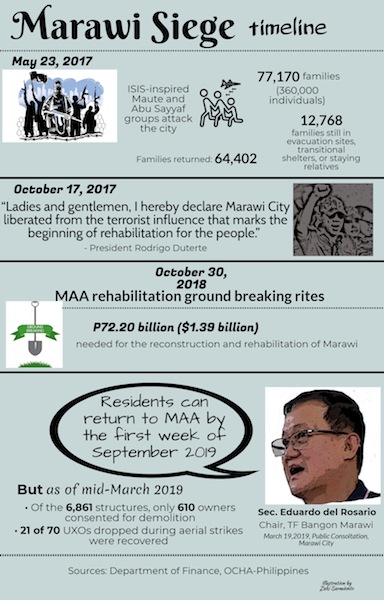
Infographics by ZAKI C. SARMIENTO
Home by September?
Secretary Eduardo del Rosario, TFBM chair and the country’s housing czar, set the deadline for the clearing of debris and unexploded ordnance this August 30.
Speaking on March 19 before hundreds of residents attending the “Consultation Dialogue with the IDPs (internally displace persons) within the MAA (24 barangays) in Marawi City,” the retired military general said that MAA residents will be allowed to return by the “first week of September” to repair their destroyed properties.
Residents of the least affected areas of the MAA might even be allowed to return “as early as July,” but they need to get permits first from the city government before they can repair their properties, he added.
Del Rosario set the completion of Marawi’s total rehabilitation “by December 2021,” even if reconstruction works at the MAA is not yet in full swing.
An estimated three million tons of debris were left by the Marawi siege at Ground Zero.
As of March 20, 49 unexploded ordnance (UXOs) have yet to be recovered from the 70 UXOs dropped by military aircraft, the main reason why, according to del Rosario, residents are not allowed to return back to their homes at Ground Zero.
Doubts were also raised for the return of the IDPs to Ground Zero in September since of the 6,861 structures, only 610 owners, or less than 10%, have given their consent for the demolition of their structures as of March 15.
But for Norphia Dipatuan, the mother of six who continues to suffer the harsh life at the “tent city” evacuation site especially as food rations are getting scarce and the basic necessities are lacking, she prays they can, indeed, return to their village by September so that she can return to selling cooked food and start rebuilding their broken lives.
https://www.mindanews.com/top-stories/2019/04/nearly-18-months-after-liberation-marawi-has-yet-to-rise-from-the-ashes-of-war/
Home by September?
Secretary Eduardo del Rosario, TFBM chair and the country’s housing czar, set the deadline for the clearing of debris and unexploded ordnance this August 30.
Speaking on March 19 before hundreds of residents attending the “Consultation Dialogue with the IDPs (internally displace persons) within the MAA (24 barangays) in Marawi City,” the retired military general said that MAA residents will be allowed to return by the “first week of September” to repair their destroyed properties.
Residents of the least affected areas of the MAA might even be allowed to return “as early as July,” but they need to get permits first from the city government before they can repair their properties, he added.
Del Rosario set the completion of Marawi’s total rehabilitation “by December 2021,” even if reconstruction works at the MAA is not yet in full swing.
An estimated three million tons of debris were left by the Marawi siege at Ground Zero.
As of March 20, 49 unexploded ordnance (UXOs) have yet to be recovered from the 70 UXOs dropped by military aircraft, the main reason why, according to del Rosario, residents are not allowed to return back to their homes at Ground Zero.
Doubts were also raised for the return of the IDPs to Ground Zero in September since of the 6,861 structures, only 610 owners, or less than 10%, have given their consent for the demolition of their structures as of March 15.
But for Norphia Dipatuan, the mother of six who continues to suffer the harsh life at the “tent city” evacuation site especially as food rations are getting scarce and the basic necessities are lacking, she prays they can, indeed, return to their village by September so that she can return to selling cooked food and start rebuilding their broken lives.
https://www.mindanews.com/top-stories/2019/04/nearly-18-months-after-liberation-marawi-has-yet-to-rise-from-the-ashes-of-war/

No comments:
Post a Comment
Note: Only a member of this blog may post a comment.